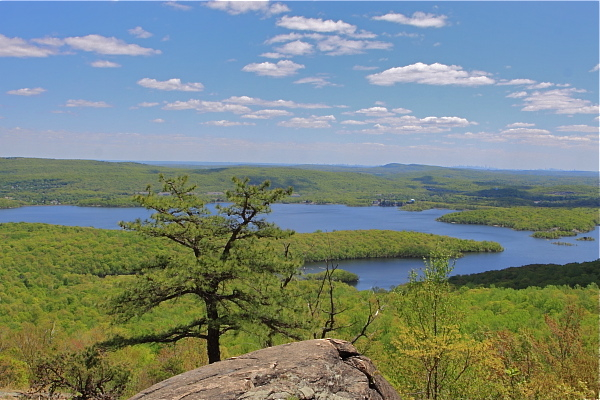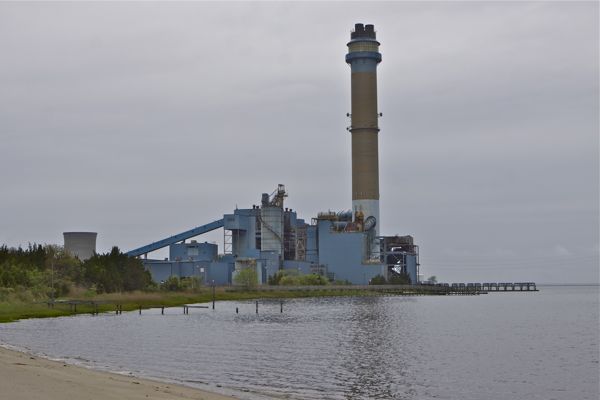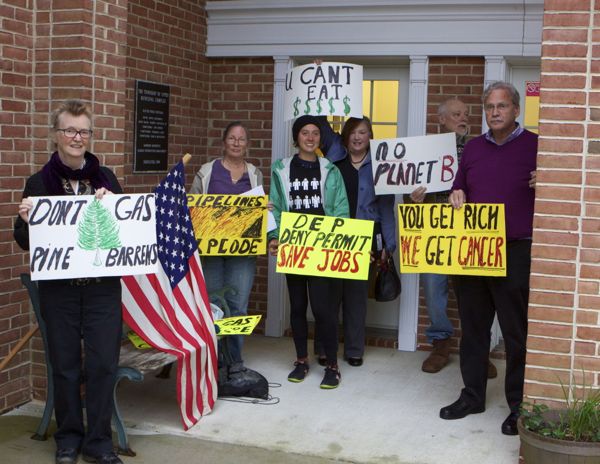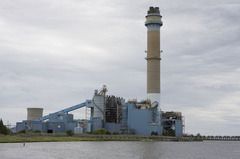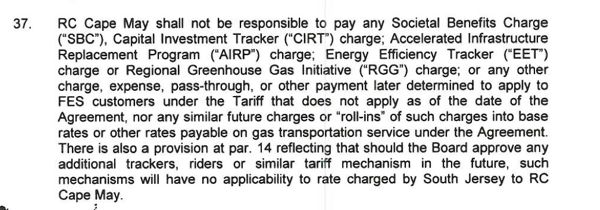Sponsors of Highlands Act Urged to Veto Christie DEP Proposed Rollback of Groundwater Protection As “Inconsistent with Legislative Intent”
An Open Letter
Dear Senator Smith and Assemblyman McKeon:
I am writing to you as prime sponsors of the Highlands Water Protection and Planning Act (Act).
On May 2, 2016, the Department of Environmental Protection (DEP) proposed amendments to the current septic system density standards in the Highlands Water Protection and Planning Act Rules (Highlands Rules) at N.J.A.C. 7:38-3.4(b). see this.
The proposed amendments would roll back and weaken protections of groundwater quality in the Preservation Area of the Highlands by increasing the allowable density of septic systems and thereby allow significant increases in development in the Preservation Area.
The DEP proposal itself estimates this increased allowable development:
The parcel analysis indicates that the proposed amendments to the septic system density standards could result in up to 1,145 additional septic systems, or about 12 percent more individual septic systems than under the existing rule. (@ page 19)
The proposal would violate the express legislative policy and standards of the Highlands Act and is inconsistent with legislative intent, as summarized below.
Contrary to the policy, standards, and legislative intent of the Act, the DEP proposal would
- allow additional degradation of water quality, not prevent degradation
- weaken regulatory protections, not strengthen them
- promote development in the Preservation Area, not restrict it
- ignore “deep aquifer recharge”, not consider and set septic standards based on it
Therefore, we urge you to exercise your Constitutional oversight and power to review and veto this DEP proposal as inconsistent with legislative intent.
I) Relevant Legislative Intent of the Act:
The following legislative findings express and form the relevant basis for understanding the current septic density standards and how the proposal would weaken them and conflict with legislative intent.
1. Prevent degradation of water quality from sprawl development
The Legislature expressed a clear and strong intent to preserve, among other things, the water quality of the Highlands region, for multiple reasons and the multiple benefits provided by clean water:
The Legislature further finds and declares that the New Jersey Highlands is an essential source of drinking water, providing clean and plentiful drinking water for one-half of the State’s population, including communities beyond the New Jersey Highlands, from only 13 percent of the State’s land area; that the New Jersey Highlands contains other exceptional natural resources such as clean air, contiguous forest lands, wetlands, pristine watersheds, and habitat for fauna and flora, includes many sites of historic significance, and provides abundant recreational opportunities for the citizens of the State.
The Legislature found that the primary threat to the resources of the region was land development, that must be strictly limited by stringent regulation:
The Legislature further finds and declares that, since 1984, 65,000 acres, or over 100 square miles, of the New Jersey Highlands have been lost to development; that sprawl and the pace of development in the region has dramatically increased, with the rate of loss of forested lands and wetlands more than doubling since 1995; that the New Jersey Highlands, because of its proximity to rapidly expanding suburban areas, is at serious risk of being fragmented and consumed by unplanned development; and that the existing land use and environmental regulation system cannot protect the water and natural resources of the New Jersey Highlands against the environmental impacts of sprawl development.
2. Finding that existing DEP regulatory scheme was not adequate to protect water quality
The Legislature based the Act upon a finding that then existing DEP regulations – including the existing regulation of septic systems and groundwater – were not sufficiently protective:
“… The Legislature finds and declares that … the existing land use and environmental regulation system cannot protect the water and natural resources of the New Jersey Highlands against the environmental impacts of sprawl development.”
3. Need to establish A New Strict DEP regulatory regime
Based upon the important water and natural resources of the region and the fact that current land use and DEP regulations cannot protect those resources, the legislature found:
that the State should take action to delineate within the New Jersey Highlands a preservation area of exceptional natural resource value that includes watershed protection and other environmentally sensitive lands where stringent protection policies should be implemented; that a regional approach to land use planning in the preservation area should be established to replace the existing uncoordinated system; that such a new regional approach to land use planning should be complemented by increased standards more protective of the environment established by the Department of Environmental Protection for development in the preservation area of the New Jersey Highlands
“comprehensive approach to the protection of the water and other natural resources of the New Jersey Highlands, that this comprehensive approach should consist of the identification of a preservation area of the New Jersey Highlands that would be subjected to stringent water and natural resource protection standards, policies, planning, and regulation” … that this comprehensive approach should also include the adoption by the Department of Environmental Protection of stringent standards governing major development in the Highlands preservation area.
The current DEP septic density rules are a core feature of the DEP’s comprehensive regulatory scheme authorized by the Act that was designed to implement these findings and provisions of the Act.
To understand the Legislature’s findings and intent regarding deficiencies in DEP’s regulatory framework with respect to the septic density standards, you need to understand the DEP’s nitrate dilution approach PRIOR to passage of the Act – which the Act sought to strengthen.
The DEP’s nitrate/septic regulatory framework that existed prior to the Act which the legislature found “cannot” protect the Preservation Area’s resources from development and sought to strengthen included the following significant limitations:
a) the antidegradation policy in the GWQS, which allowed degradation of 50% of the difference between local background and the 10 mg/L GWQS, typically resulting in a nitrate target value of 5.5 mg/L. and lot sizes of 4-6 acres;
b) the nitrate dilution and recharge parameters of NJ GSR 32, which were deemed inappropriate because they did NOT accurately reflect the geology and recharge characteristics of the Highlands region:
c) The GSR 32 method was also rejected by the Legislature because it failed to consider cumulative impacts, allowed too much water quality degradation, did not include a nitrate target based on natural background conditions, and generally produced lot sizes in the range of 6 – 10 acres, which were deemed to be inadequate to protect the water resources and large blocks of forests in the region.
Here is the DEP Guidance for how that model was implemented in the DEP permit program for 50 or more septic units: (note nitrate targets of 5.2 mg/L – to 8 mg/L):
- Calculating Lot Density Using the Model – …. The background ground water quality for NO3-N is 0.4 mg/L and the nitrate target is 5.2 mg/L, to be consistent with N.J.A.C. 7:9-6 (unless background ground water quality is determined on a site-specific basis through a ground water sampling plan as approved by the Department in writing or when projects are located in Class I aquifers as defined in N.J.A.C. 7:9-6);
-
Step 2: Determining the total area of the residential development
When using clustering, please be aware that in order to protect each individual home form possible contamination from their well or their neighbor’s well, the target is 8 mg/L, which is below the drinking water standard of 10 mg/L
Please keep in mind the key legislative, policy, and technical differences between the prior septic rules, the current septic rules that replaced them, and the proposed new septic rules that would weaken the current rules..
II) Legislative Standards for DEP Septic Density
The Highlands Act requires the Department to establish a septic density standard. The septic density standards are authorized by the following provision of the Highlands Act( C.13:20-32 Rules, regulations, standards.; P.L. 2004, c.120):
“a septic system density standard established at a level at a level to prevent the degradation of water quality, or to require the restoration of water quality, and to protect ecological uses from individual, secondary, and cumulative impacts in consideration of deep aquifer recharge available for dilution” See N.J.S.A. 13:20-32e.
The Legislative policy and standard for DEP’s regulatory septic density standard is to “prevent the degradation of water quality“.
Importantly, the regulatory septic density standard set by the Department must be done explicitly “in consideration of deep aquifer recharge available for dilution”.
The current DEP septic density standards were derived based upon this preventive policy and standard.
DEP derived the current septic density standards based on “pristine” background groundwater quality conditions that did not reflect anthropogenic sources of groundwater pollution.
See DEP’s Basis & Background of the Septic Density Standard which correctly noted the legislative policy context (see: Nitrate Target Concentration, p.17)
The context for method selection must be guided by the intent of the legislation, which is to protect and restore ground water and surface water quality. […]
In light of the direction in the HWPPA to select a septic density that would not degrade water quality, the Department considered two land use scenarios, recognizing that the underlying ground water would have different ambient qualities depending on the presence/absence of anthropogenic inputs. The Department performed numerous exercises with available data and referred to numerous sources to assess ambient nitrate concentration specific to two land cover designations: forested and mixed land use. […]
To assess nitrate levels under conditions that best represent pristine in contemporary terms, the monitored wells were then selected based on the 500-meter buffer containing equal to or greater than 90% forest + wetlands + water, e.g., less than 10% urban, agricultural, or barren land use.
Accordingly, to reflect the clear Legislative intent and strict legislative preventative standard, the current DEP septic density regulatory standards are conservative and were based upon the following nitrate target concentrations
Two ambient nitrate concentration standards were selected, 0.21 mg/L for forest land use and 0.76 mg/L for mixed land use. (page 1)
III) Proposal Conflicts with Legislative Policy and Septic Density Standard
The DEP’s proposed new septic density standards conflict with both legislative intent and the legislative standards established by the Act.
The DEP proposal does not “prevent the degradation of water quality” as mandated by the Act. In fact, it explicitly allows degradation of water quality because the “target concentration” for pollution in groundwater is NOT based on “pristine” background conditions.
In the proposed new rules, the DEP simply moved the goalposts from a density standard based on natural background conditions (e.g. “pristine”) to a standard based on groundwater that has already been polluted by septic systems and agricultural chemicals and animals.
Here is a side by side comparison of the current septic density standards and the proposed new standards.
Here is the NJ DEP Regulatory Basis for the current standards:
The context for method selection must be guided by the intent of the legislation, which is to protect and restore ground water and surface water quality. […]
Two ambient nitrate concentration standards were selected, 0.21 mg/L for forest land use and 0.76 mg/L for mixed land use.
Here is the basis from the USGS Study (August 2015):
The estimated median nitrate concentration for the entire Highlands Region is about1.25 mg/L as N, and estimated median concentrations range from about 1.05 to 1.78 mg/L as N among 11 smaller administratively defined areas within the Highlands Region that vary in percentages of urban land use, agricultural land use, and septic-system density.
The change from the original DEP “nitrate target concentration” of 0.21 mg/L – and 0.76 mg/L based on “pristine” or natural background concentrations to the USGS median regional anthropogenic impacted values decreases lot sizes tremendously.
Th current lot sizes under the current septic density standards are 88 acres in forested areas and 25 acres on farmlands.
The proposed new lot sizes under the proposed new rule are 23 acres in forested areas and just 11 and 12 in farmlands.
By DEP’s estimate, the proposed new standards would increase development significantly:
The parcel analysis indicates that the proposed amendments to the septic system density standards could result in up to 1,145 additional septic systems, or about 12 percent more individual septic systems than under the existing rule. (proposal at page 19).
By definition and by the best available science, we know that increasing septic density and allowing at least 1,145 additional septic systems that discharge to Highlands Preservation Area groundwater – at least a 12% increase – will cause a decrease in water quality.
In addition to the direct discharge of pollutants from septic systems to groundwater, the development that uses these new septic systems will convert natural lands to impervious surface, which decreases recharge and increase runoff and non-point source pollution, which degrades and impairs surface water quality.
The DEP’s own projected results of the additional new development and ground and surface water degradation violate the letter and intent of the Act.
Additionally, the DEP’s proposed new septic density standards were not derived “in consideration of deep aquifer recharge available for dilution” as expressly mandated by the Act.
The DEP based the new standards on a USGS study. The USGS study relied almost exclusively (96% of data) on data from the NJ Private Well Testing Act. According to USGS own study, the source of the PWTA data was shallow residential wells and the data did not include well depth or aquifer, which are essential data attributes required to determine if “deep aquifer recharge” is considered. See the PEER complaint below for further discussion of this fatal flaw.
IV) Inconsistencies with Legislative Intent
The DEP estimates that the proposed new rule would allow at least an additional 1,145 septic systems and significant new development in the Preservation Area.
That is contrary to the express intent of the legislature to prevent degradation of water quality, more strictly regulate development, and protect natural resources, as outlined above.
V) Flaws in USGS study that forms exclusive basis for proposal
The DEP proposal is based exclusively on a 2015 Report by the USGS.
The August 2015 study by scientists at the U.S. Geological Survey (USGS) is entitled “Median Nitrate Concentrations in Groundwater in the New Jersey Highlands Region Estimated Using Regression Models and Land-Surface Characteristics.” In an April 21, 2016 news release, the New Jersey Department of Environmental Protection (DEP) touted the study as “comprehensive new scientific information” which supported what the agency termed “common sense revisions to Highlands septic density standards.”
Rather than being based on either new or comprehensive scientific information, the USGS study is actually based on old state data of extremely poor quality and reliability. The PEER complaint points out that 96% of the study’s data is drawn from the state’s Private Well Testing program which even the DEP concedes is highly questionable for a number of reasons, including that the data is –
- Unverified with no quality controls to confirm validity;
- Skewed and not necessarily representative of the Highlands deep aquifer; and
- Drawn from wells outside the Highlands Preservation Area.
In order to correct and remedy those flaws, Public Employees for Environmental Responsibility (PEER) filed a federal Data Quality Act complaint with the USGS, requesting that the flawed study be withdraw.
The PEER complaint goes into detail and provides an additional demonstration of how the proposed DEP rule is inconsistent with Legislative intent.
You may read the PEER petition here.
We urge you to defend the legacy of the Highlands Act, veto this DEP proposal as inconsistent with Legislative intent, and look forward to your pompt and favorable consideration.
Bill Wolfe,
Bordentown, NJ
